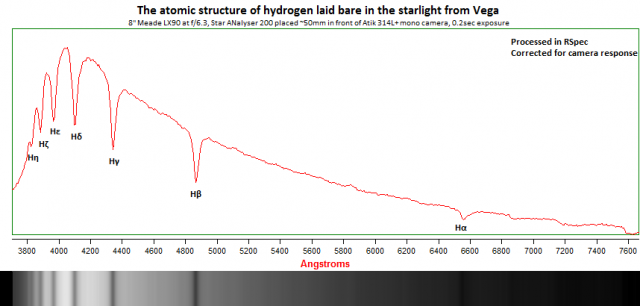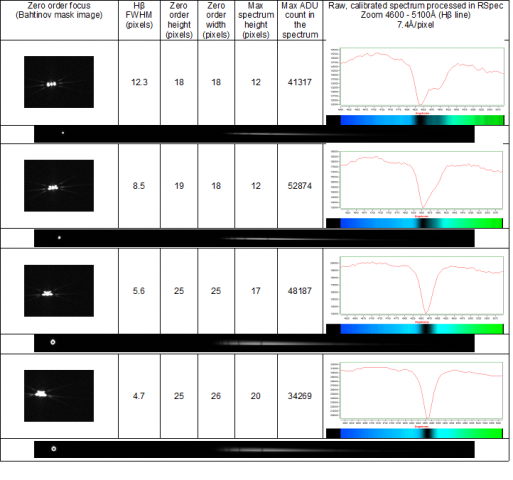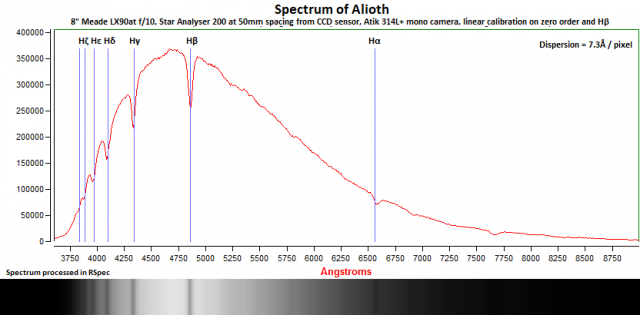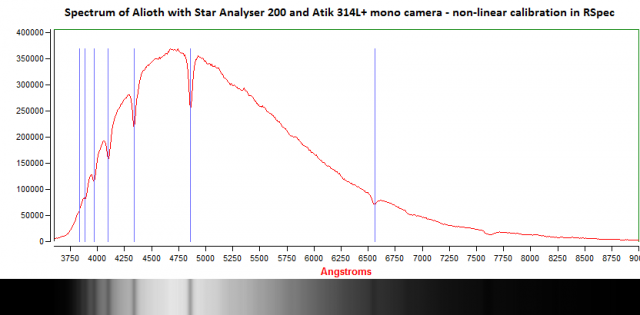› Forums › Spectroscopy › Introduction to spectroscopy
- This topic has 23 replies, 5 voices, and was last updated 7 years, 11 months ago by
 David Swan.
David Swan.
-
AuthorPosts
-
11 January 2018 at 7:50 pm #573920
 David SwanParticipant
David SwanParticipantHello,
I’ve decided to take a first step into spectroscopy – I’ve just ordered a star analyser (100). I’d be interested to hear from those in the know what I should start reading and doing. The weather is terrible – thick cloud seemingly forecast forever (!) – so picking up Balmer lines in the spectrum of Vega would be a stretch at the moment.
Thanks,
David Swan
11 January 2018 at 10:13 pm #578951 Dr Andrew SmithParticipant
Dr Andrew SmithParticipantDavid look at Robin Leadbeater’s site as he designed the Star Analyser! Google Three Hills Observatory.
Regards Andrew
11 January 2018 at 10:45 pm #578952 David SwanParticipant
David SwanParticipantThanks Andrew – I’ve had a quick look and indeed there’s lots there! David
11 January 2018 at 11:20 pm #578953 Robin LeadbeaterParticipant
Robin LeadbeaterParticipantSome additional words from the master. No not me! but Christian Buil who’s work with a simple school lab diffraction grating got me into this game.
The theory and early experiments.
http://www.astrosurf.com/buil/us/spe1/spectro1.htm
Star Analyser review and tips
http://www.astrosurf.com/buil/staranalyser2/evaluation_en.htm
http://www.astrosurf.com/buil/staranalyser/obs.htm
http://www.astrosurf.com/aras/staranalyser/userguide.htm
(Dont worry at this stage about the wedge prism he uses, it is available as an accessory but only improves the resolution of the SA100 slightly and makes life more complicated for the beginner.)
Robin
11 January 2018 at 11:34 pm #578954 Robin LeadbeaterParticipant
Robin LeadbeaterParticipantJim Ferreira’s website also has some nice examples of Star Analyser targets to whet your appetite while we wait for the skies to clear
http://www.lafterhall.com/spectroscopy.html
Cheers
Robin
12 January 2018 at 6:12 am #578955 David SwanParticipant
David SwanParticipantThanks Robin – David
12 January 2018 at 5:35 pm #578958 Andy WilsonKeymaster
Andy WilsonKeymasterHi David,
You have already received some great advice for getting started with the links posted by Andrew and Robin. I started out by reading books on the subject, but there is no one book that I would recommend as the best starting point. I can always recommend a few, but you may be able to get all you need from the internet to get going without having to spend money on books.
Starting off with a nice easy target like Vega is definitely the right way to go. I found it took me a few months to learn how to use my setup and get comfortable with the processing, but I was still able to get some pleasing results right from the start. The star analyser is an excellent way to learn. As well as being simple it will also allow you to go fainter than with higher resolution spectrographs, so there are a whole range of targets you can observe.
Good luck and please keep us posted on how you get on.
Andy
12 January 2018 at 9:56 pm #578959 Hugh AllenParticipant
Hugh AllenParticipantHi David,
Congratulations on taking the plunge, I am sure you’ll really enjoy spectroscopy. I think a spectroscope is a wonderful observing tool but many starters seem to fall by the way side. I’d echo the advice to stay initially on bright targets, ideally A- and B-type main sequence stars that have strong Balmer absorption lines. This will allow you easily to see when things are not working so that you can quickly develop understanding of spectrum image capture and processing without losing heart. I think a key thing to learn is good focusing of the spectrum. Here’s a study I did on Vega with my Star Analyser 200 to find the optimum focus point for the sharpest spectrum (narrowest, deepest absorption line). It is not perfect focus on the star itself but slightly backed off. The Bahtinov mask focus image shows that very clearly. When I use my Star Analyser I begin each session by setting the focus on a bright A-type star. Good luck and of course feel free to ask any questions
Cheers
Hugh

 13 January 2018 at 11:05 am #578960
13 January 2018 at 11:05 am #578960 David SwanParticipant
David SwanParticipantI’ll keep you informed on how I get on. There was a 10min gap in the clouds yesterday… David
14 January 2018 at 1:57 pm #578966 David SwanParticipant
David SwanParticipantI’ve carried out my first capture. Not an ideal target I gather, but the weather isn’t cooperating! I’ve done the wavelength calibration – with the star image and hydrogen alpha line. Focus is definitely something I’ll work on; and exposure time too. David
14 January 2018 at 5:00 pm #578967 Dr Andrew SmithParticipant
Dr Andrew SmithParticipantWell done David you will soon have this licked into shape.
Regards Andrew
14 January 2018 at 6:17 pm #578968 Hugh AllenParticipant
Hugh AllenParticipantHi again David,
As Andrew said, that’s a nice first spectrum. And isn’t it great that spectroscopy can be done through cloud, moonlight and light pollution! Alioth is a normal A-type giant star so the Balmer absorption lines are strong and still reasonably broad, perfect for the Star Analyser. The shallow absorption lines in your profile could be because of focus, or I suspect maybe also overexposure? The pixel map option in RSpec gives a nice way of evaluating the exposure of each pixel – if you look at the pixels around the peak brightness in your profile (near 4500Å) the brightest pixels should be no more than 80-85% of the peak ADU from your camera (so 80-85% of 65,536 if you’re using a 16-bit camera). Once you’re happy with exposure and focus so that you’re getting nice deep absorption lines I’d recommend a non-linear calibration in RSpec. The spectrum from the Star Analyser is surprisingly non-linear; here’s a comparison I made of the spectrum of Alioth (like your spectrum, not yet response corrected) with linear and non-linear calibration in RSpec.
Cheers
Hugh

 14 January 2018 at 6:22 pm #578969
14 January 2018 at 6:22 pm #578969 David SwanParticipant
David SwanParticipantYes, I think overexposure is likely. I’ll look into the brightness values. Vega of course is low in the evening, and with this being early days (in spec) for me, I thought I’d go for a convenient target from my backyard. Thanks Hugh – David
15 January 2018 at 8:48 pm #578971 David SwanParticipant
David SwanParticipantI’ve posted a much better effort on my member’s page. With my first go, I thought stacking and sharpening a load of images (a la planetary imaging) would help things, but I think it actually blurred the spectrum – and the bit depth was 8 bit anyhow. This time I was careful with focusing and made sure the exposure wasn’t too high. I think the result is much better. Unfortunately the ADU of my camera is 14 rather than 16 bit, so there’s not quite as much data as there could be.
16 January 2018 at 1:28 pm #578972 Andy WilsonKeymaster
Andy WilsonKeymasterThat is a nice spectrum of Alioth on your member page, showing the hydrogen absorption lines.
Stacking is useful for fainter targets to increase the signal. However, you need good tracking for it to work well with a star analyser, to avoid any drift of the star. If there is even a slight drift then this can blur the spectrum, which might be what you were seeing. One way to reduce the problem is to align the wavelength axis of the spectrum North South, on the assumption that any drift will be East West. This could even help by spreading the spectrum over a few pixels, but requires that you have no drift in the North South direction.
Sharpening should normally be avoided. The algorithms can introduce artefacts and change the line profiles. I have heard of it occasionally being used to bring out faint lines, but it is very risky and will invalidate most of the scientific data contained within the spectrum.
Cheers
Andy
16 January 2018 at 4:37 pm #578975 Robin LeadbeaterParticipant
Robin LeadbeaterParticipantHi Hugh,
The SA 100 should be more linear than the SA200 because of the lower dispersion angle but I think the wavelength errors you are seeing may be more to do with the zero order not quite being in the expected place (ie at 0 Angstroms) ie it is more of an offset error than a non linearity. I have seen this to a greater or lesser extent from time to time and never really managed to nail down the cause. (Something to do with atmospheric dispersion perhaps ? What does a linear fit between the shortest and longest wavelength Balmer lines look like for example ? At the end of the day though wavelength calibration of a slitless system and the transfer of that calibration to other targets is always going to be somewhat approximate.
Cheers
Robin
16 January 2018 at 4:42 pm #578976 David SwanParticipant
David SwanParticipantI’ll not do any sharpening. It was easy enough anyway to scan through the frames by eye and then select the best; no computer programme is required for that. The seeing yesterday was extremely bad – as unstable as I’ve ever seen it would not be an exaggeration.
16 January 2018 at 4:49 pm #578977 David SwanParticipant
David SwanParticipantYes, with the frames I look last night: for some, a two point calibration with zero and hydrogen beta seemed to work very nicely, with the alpha, beta, gamma and delta Balmer lines superimposing precisely on target in RSpec. In other frames this wasn’t the case. I guess it is just an effect of seeing? I am looking forward to seeing the spectra of SN2018gj that will appear over the next few days. I note you are discussing the uncertainty around the SNII subtype on the ARAS forum. David
16 January 2018 at 5:48 pm #578978 Robin LeadbeaterParticipant
Robin LeadbeaterParticipantHi David
There’s no substitute for good seeing to get decent resolution with the Star Analyser but with bright targets you can try using short exposures and select, align (on the zero order or sometimes better on a prominent line if the stacking program will lock onto it) and stack as the planetary imagers do. This helps with dynamic range when using video type cameras as well as generally improving sharpness of the spectrum but the problem is that that the variations are wavelength dependent. (hence the twinking colours seen with bright stars in bad seeing) so the spectrum can still end up blurred.
Cheers
Robin
16 January 2018 at 6:03 pm #578979 Robin LeadbeaterParticipant
Robin LeadbeaterParticipantYes that was a good result on SN2018gj at mag 14.5 by Etienne Bertrand using a standard ALPY. I see there is now a professional confirmation of type II too
http://www.astronomerstelegram.org/?read=11172
Looking at the weather forecast my next clear spell is likely be Saturday evening when I am down at Burlington House talking about…. supernova spectroscopy ! If it had been a type Ia it would probably have got pretty bright, perhaps mag 12 but as a type II, maximum will be less certain and probably lower.
Cheers
Robin
-
AuthorPosts
- You must be logged in to reply to this topic.
